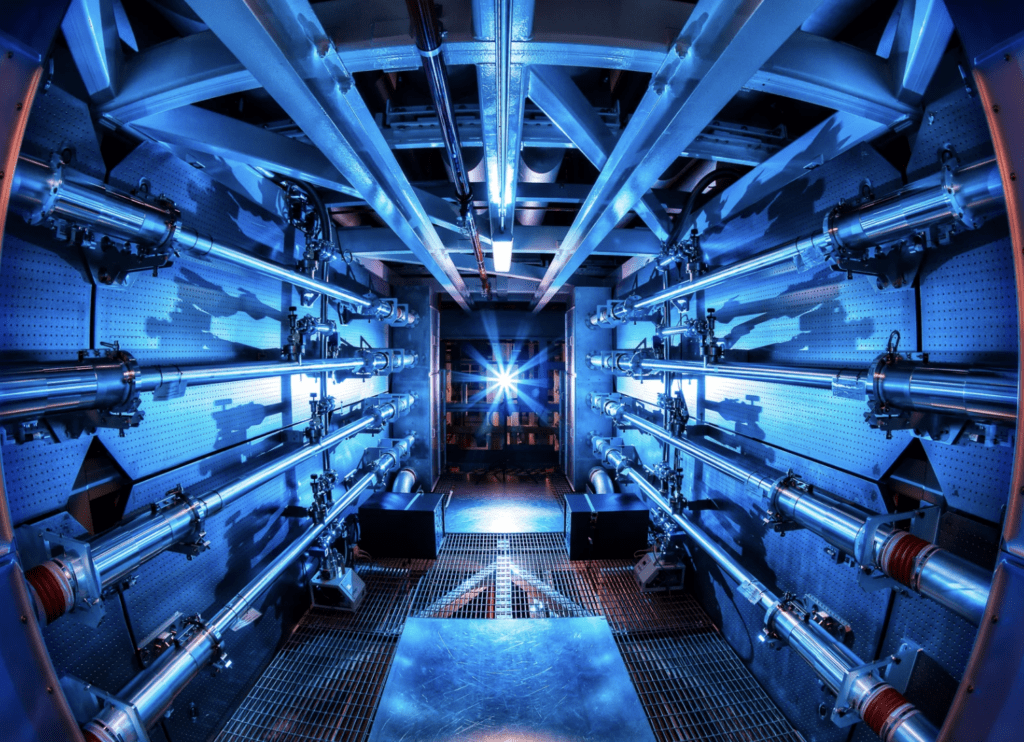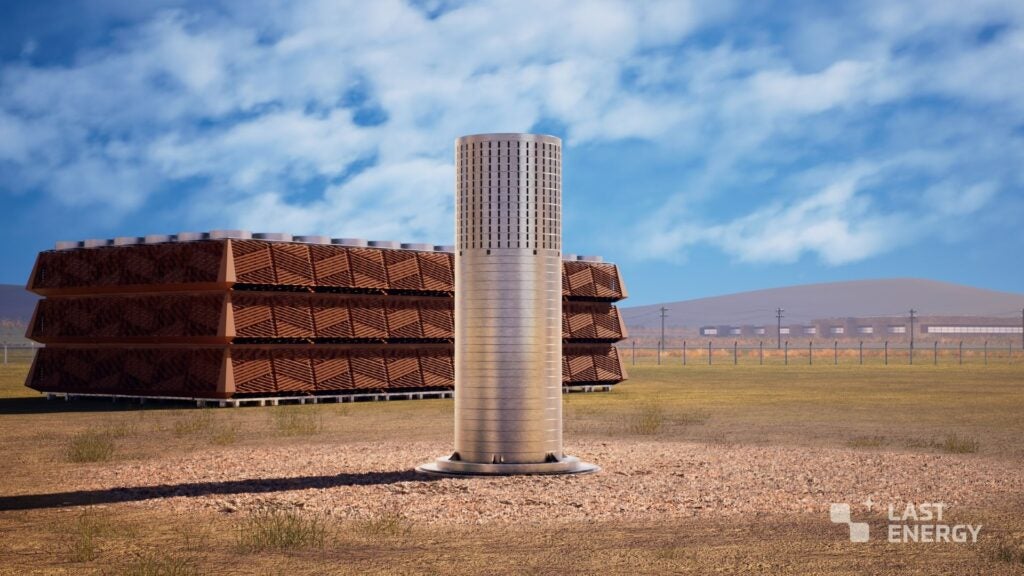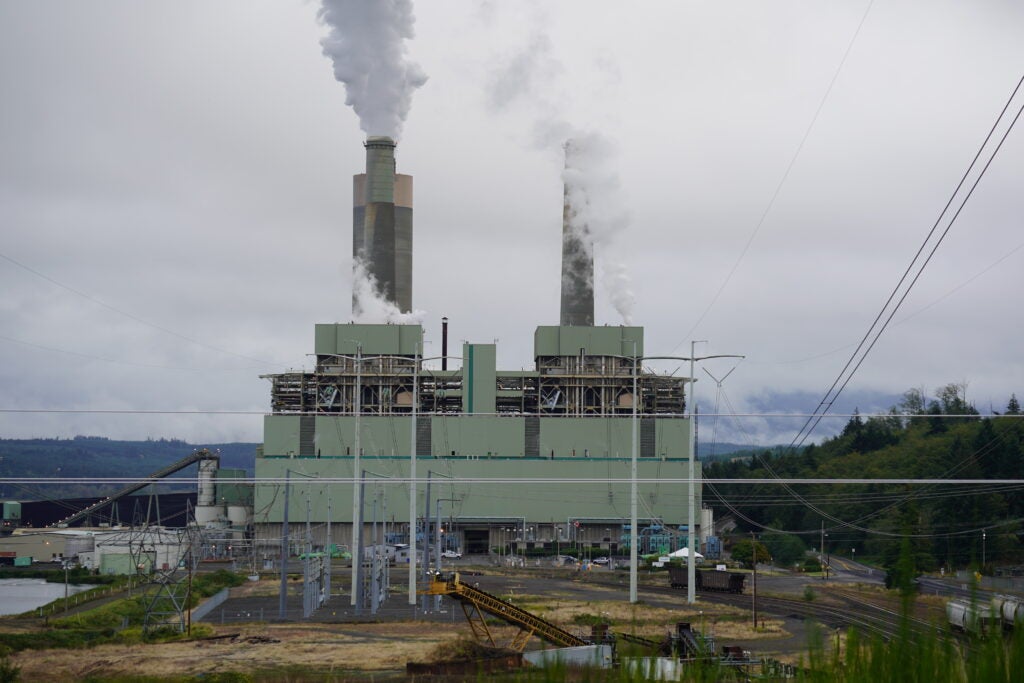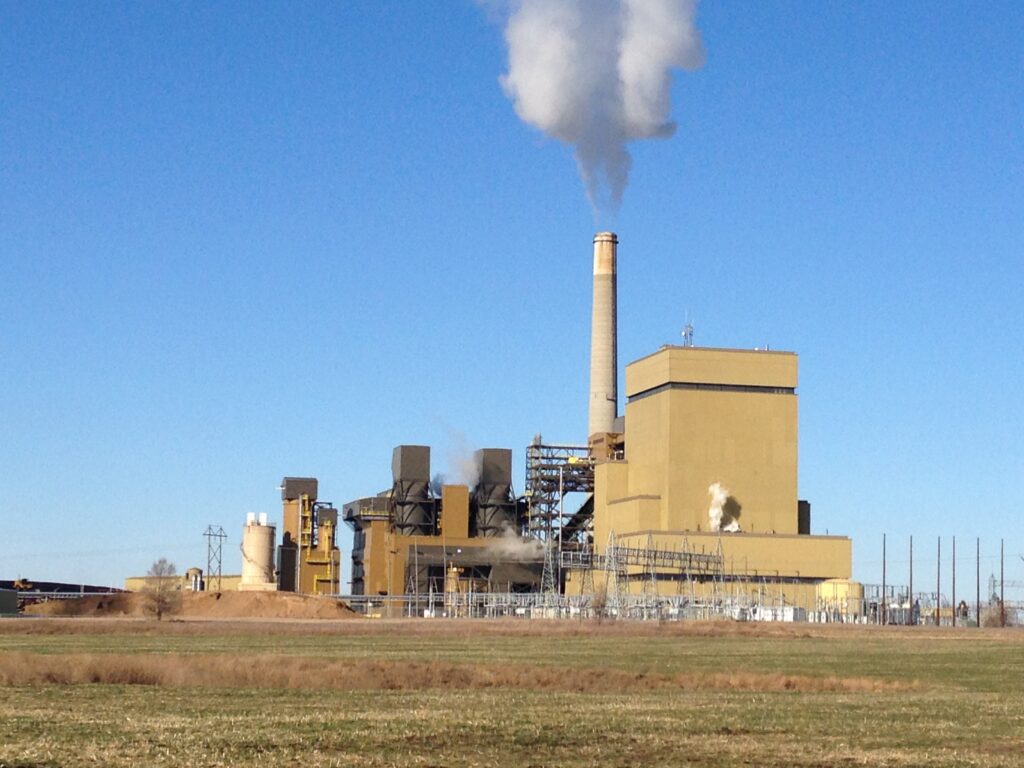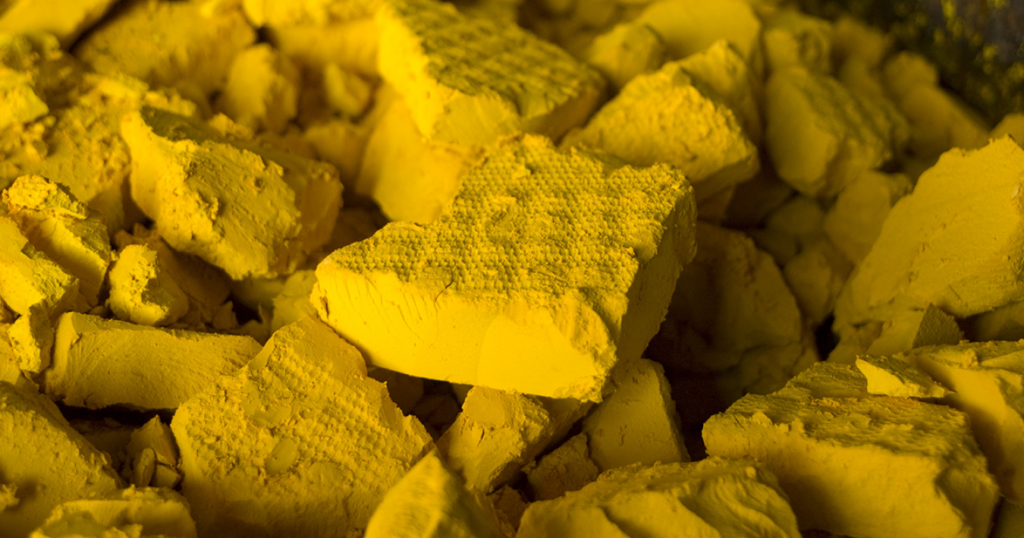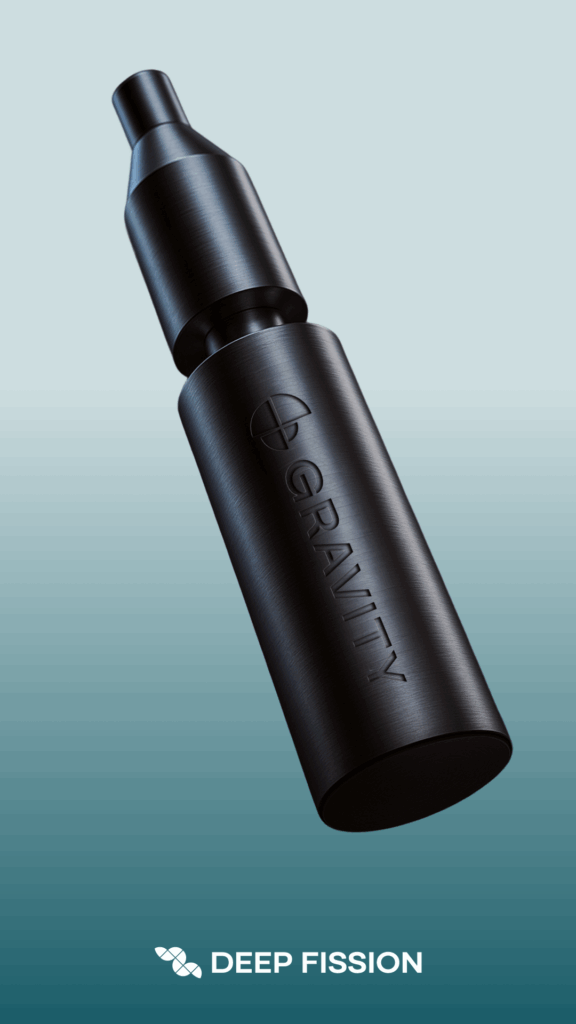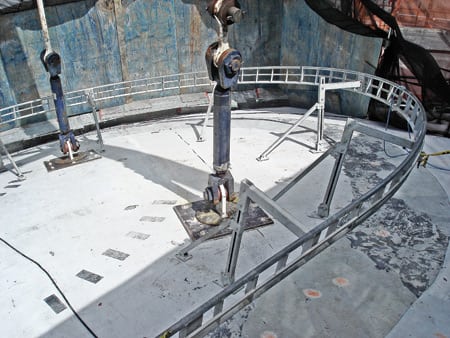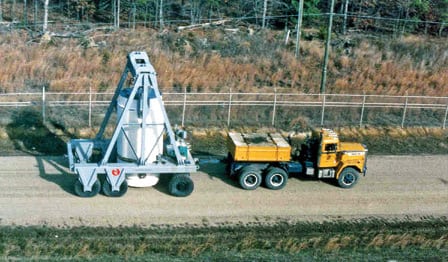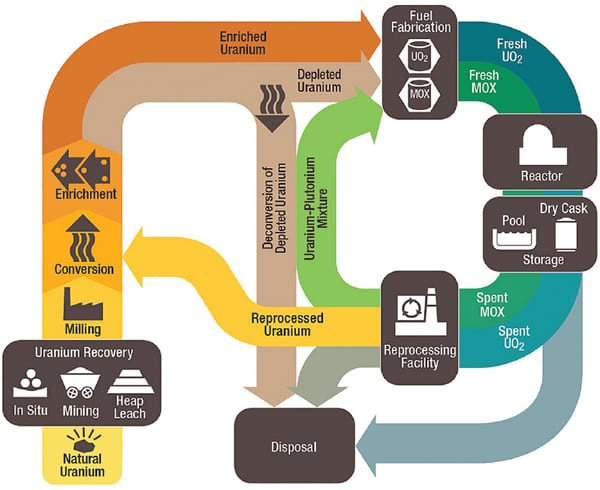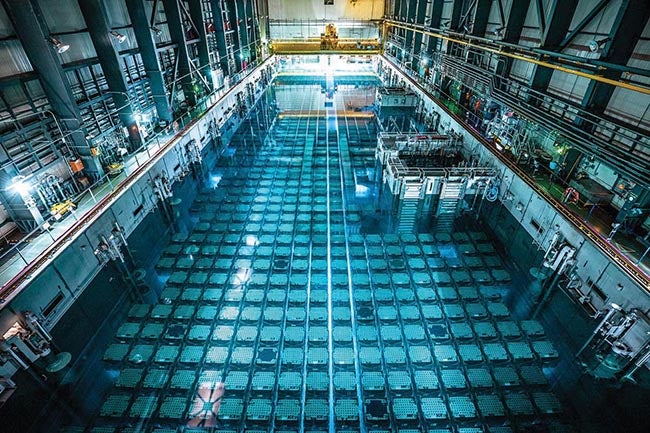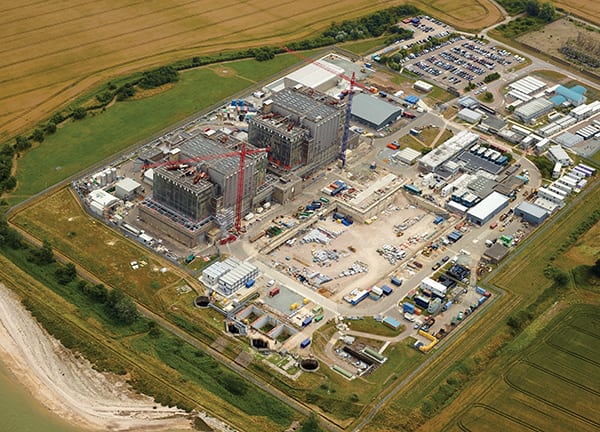Heavy loads must often be moved at power plants of all types. Air bearing-based vehicles can make the process safer, faster, and cheaper. Cask relocation at a nuclear waste facility offers one successful example of the process in action.
Load moving in the nuclear industry comes with unique challenges, particularly when the cargo is high-level radioactive waste (HLW) stored in specially sealed canisters. The common method for moving these types of casks is with wheeled casters and rails. However, the technique is inefficient and costly due to lack of mobility and inherent risks associated with the process. When a load becomes imbalanced, the floor beneath the track can be damaged to the point of halting the entire project until the flooring can be replaced. There is literally no margin for error and certainly no quick turnaround should an incident like this occur.
As an alternative, several facilities have turned to air bearing-based vehicles, instead of inflexible wheeled rollers or forklifts, with considerable success. One 200-acre site in New York successfully relocated nearly 24,000 tons of radioactive waste using air bearing-based vehicles.
The Challenge for West Valley Nuclear Waste Facility
Launched more than 50 years ago, West Valley Nuclear Waste Facility, located 35 miles south of Buffalo, New York, was at one time the only commercial nuclear fuel reprocessing center in the U.S. From 1966 to 1972, the site accepted and reprocessed spent nuclear fuel from the production of plutonium and uranium for weapons. Suppliers of the spent fuel were other commercial and U.S. Department of Energy (DOE) facilities with reactors. According to the New York State Department of Environmental Conservation, the site also housed a variety of other radioactive wastes and “left behind a legacy of radioactive contamination” when it ceased operations in 1975. Recognizing the mammoth and costly task involved in a cleanup and relocation of HLW, the state appealed and received help from the federal government through a congressional act in 1980.
How mammoth? A vitrification facility, which supports a storage process in which nuclear waste is mixed with chemicals to form molten glass, was constructed on the site in the 1980s. Between 1996 and 2002, 600,000 gallons of liquid and sludge in two underground storage containers were vitrified.
“This had to be the most highly radioactive waste in the DOE in the United States,” said Dan Meess, a chief engineer working at the West Valley Demonstration Project where a $464 million contract was awarded for Phase I decommissioning activities. Meess has been working on-site for the last six years.
“We made 275 high-level waste stainless steel canisters around 10 feet high, two feet in diameter, filled them with molten glass and let them solidify,” Meess said, adding that caps on the open end of the canister had to be sealed remotely. From 2002 to 2015, the canisters—each weighing 5,000 pounds—sat in racks inside the facility’s Main Plant Process Building, a structure built in the 1960s and slated for demolition.
According to Babcock and Wilcox, the prime contractors at West Valley, each canister has “a minimum 50-year life expectancy.” The canisters had to be relocated, but with no federal waste repository available to accept them, they had to be moved to a specially constructed 16,000-square-foot storage pad with a three-foot-thick foundation a quarter-mile from the building. West Valley, in effect, became the first site in the U.S. to place HLW into long-term outdoor storage.
The company determined the most efficient way to move the inventory would be to load one cask at a time into a liner capable of housing five canisters. Each cask had a bolted steel and concrete cover to shield the high radiation levels, along with a welded stainless-steel lid for the liner. All of the operations had to be performed by a remote operator. The weight of each cask with the five canisters was 87 tons.
Relocation to the storage pad was expected to take two years given the relatively tight quarters in the building and the limitations of conventional moving apparatus. Reinforced flooring would also have to be installed to handle the excessive weight.
Movement Options
The process for removing just one cask was expected to take up to seven days assuming no other issues developed. Given the time constraints, costs for relocation were anticipated to increase by millions of dollars.
The West Valley Demonstration Project team reviewed the movement and relocation options considering safety, efficiency, and cost-effectiveness. At first, it appeared those options were limited.
“We had an extremely heavy piece of equipment similar to a forklift that was very long with a counterweight that stuck out,” Meess recalled. “It was massive to work in our confined spaces and we would have only been able to do one cask at a time.”
Cranes, often an option for other segments of the power industry, were ruled out at West Valley due to cost and space limitations. Another important consideration was the inability of the facility’s flooring to support the weight if not reinforced or replaced prior to moving major components.
Facilities using rollers on a track to move their heavy equipment must ensure their flooring is not only strong enough to withstand the weight, but perfectly flat. A seemingly innocuous imperfection in the floor could cause load weight to shift, possibly damaging the equipment and flooring. Flexibility during movement is non-existent as the rollers/track are fixed in place. A change necessitated by a turn or in-path obstacles will stop the process until the track can be re-set. Similarly, if a load on rubber wheels comes into contact with a wall or narrow opening, side loads caused by obstruction and subsequent weight shift can cause the wheels to collapse, shutting down the move and substantially increasing the expense.
One more complication was that an average rubber wheel with a contact area of 10 square inches carrying high-tonnage equipment, such as the above described casks or a heat exchanger, could weigh as much as 6,000 pounds per square inch. No standard mezzanine or non-reinforced flooring is built to withstand that much pressure.
Weighing all the pros and cons, engineers at West Valley decided on a feasible and more cost-effective alternative. They chose air bearing-based vehicles (Figure 1), which offered increased load displacement without the downsides associated with other load-moving choices, particularly the excessively high floor loads caused by wheeled casters.
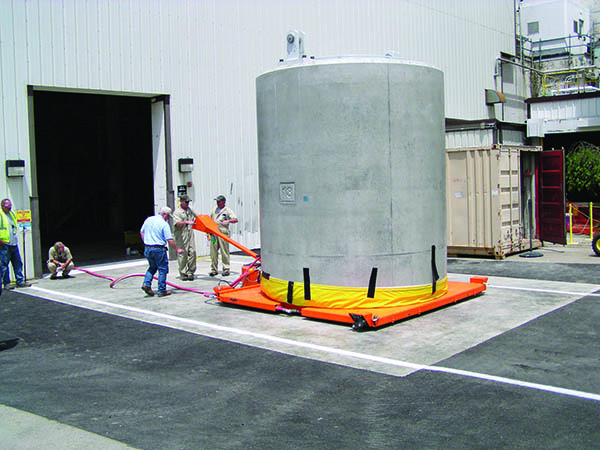 |
| 1. West Valley Nuclear utilizes a steel pallet with power drive to safely transport 87-ton casks of nuclear waste. Courtesy: AeroGo Inc. |
Air Casters and Casks
Air caster technology, regardless of the type of application, is based upon the lifting and floating of heavy loads on a film of air, which alleviates weight and friction. Lightweight air lines can be easily moved to maintain compressed air pressure. This is just one of a number of advancements that convinced the engineers to use air pallets.
Older versions of air lines weighed up to 300 pounds and required two workers to move them. The newer, lighter version weighs only 20 pounds. The air bearing fabric has also been technologically advanced. Fabric reinforcements have increased air bearings’ capabilities to accept higher air pressure and move in confined spaces.
The air bearing transport system pallet easily slides under the casks to move them out. Supervisors noted that the casks were picked up only a few inches off the floor, which enabled the remote operator to drive underneath (Figure 2), compensate and balance the load, and resume steering.
 |
| 2. Safe cask transport in tight clearance. Courtesy: AeroGo Inc. |
The advanced technology of programmable logic controllers (PLCs) enabled the process to proceed smoothly. The PLC senses and adjusts for height and weight of the casks, and rotation. Furthermore, it enables omnidirectional movement unavailable with other fixed methods of load transfers. Ultrasonic height control adjusts weight to the casters while the air bearings evenly distribute the load weight thanks to built-in suspension. Yet, the pressure of the load on the pallets throughout the cask movement process measured only 50 pounds per square inch—the same pressure as that of a 200-pound individual.
In addition, the pallets alleviated concerns about uneven balances and side loads should they strike a wall or other obstruction. The pallets easily slid past obstructions and still maintained an even weight distribution, allowing moves to continue without interruption.
Perhaps the most-appreciated benefit from the use of the air casters was the “incredible” time savings compared with other load movement processes, according to Meess.
“We thought we could process only one cask at a time due to the tight quarters,” the chief engineer recalled, “but with the flexibility of the pallets and the load distribution, we could have three casks processed at different stages simultaneously because the pallets could easily move between columns in the building.
“If we wouldn’t have had the air pallets, it would have taken us another year of processing,” Meess said. Relocation of the casks to the storage pad, expected to take at least two years, only took one, which represented a dramatic reduction of downtime. “We saved millions of dollars,” Meess said. “They performed flawlessly.”
Project Update
The West Valley Nuclear Project experience illustrates the value of air bearing-based systems for flexible moving and relocation of nuclear waste in a safe and efficient manner. Instead of incurring major expenses for equipment, such as forklift-style trucks or wheeled casters with their inherent risk of seriously damaging flooring due to excessive loads, the project discovered a functional and less-costly alternative. Meess praised the speed, efficiency, and success of the air bearing transport systems.
The contractor has since shared the air bearing technology with two other nuclear locations—the Savannah River Site in South Carolina and Hanford in Washington state, a decommissioned site where the pallets were recently shipped. With the success of West Valley as their model, both locations plan to use air caster technology to remove casks containing tons of HLW. ■
—Randy Manus is senior application specialist with Seattle, Washington-based AeroGo Inc. (www.aerogo.com).


